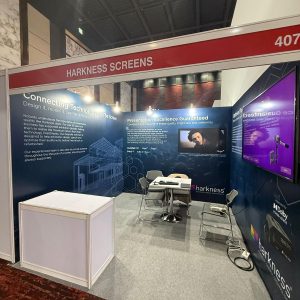July 15th, 2024
Harkness Screens Unveils Breakthrough Development in Cinema Screens for Laser Illuminated Projectors
Harkness Screens, a global leader in cinema screen technology, proudly announces the latest advancements in the development and metrology of cinema screens optimized for laser illuminated projectors. Presented by Matt Jahans, Senior VP of Technology Intelligence at Harkness Screens, this breakthrough marks a significant milestone in enhancing the cinematic experience.
Introduction to LIPA (Laser Illuminated Projection Association)
Founded in May 2011, LIPA advocates for laser illuminated projection and plays a crucial role in updating laser safety regulations. The association’s mission is to educate various industries about the benefits of laser illuminated projectors, positioning them as a superior alternative for a wide range of applications.
Expertise Behind the Innovation
With 26 years of experience in cinema technology, Matt Jahans joined Harkness Screens in 2012, bringing his extensive knowledge and expertise to the forefront of technological innovation. His leadership has been instrumental in driving the development of advanced cinema screens designed to optimize laser projection technology.
Addressing Laser Speckle in Cinema Projection
One of the critical challenges in laser projection technology is laser speckle—an interference pattern that can impact the visual quality of projections. Several factors influence speckle, including screen surface type, projector type, viewing distance, brightness levels, and content type. Harkness Screens has dedicated significant resources to understanding and mitigating these factors.
Four-Stage Development Process
Harkness Screens’ development process for cinema screens involves a rigorous four-stage methodology to ensure optimal performance and quality:
- Lab Testing
- Hundreds of samples are tested for gain, contrast, and laser speckle.
- Measurements include RGB and white laser lights to ensure comprehensive analysis.
- Visual Evaluations in Lab
- In addition to lab testing, visual assessments of speckle are conducted to gauge real-world impact.
- Internal Projection Labs
- Screens ranging from 5 to 12 meters are tested using cinema projectors.
- Evaluations encompass different geometries, distances, and projectors to simulate various viewing environments.
- Real Cinema Testing
- Final testing is performed in real cinemas with trusted partners, incorporating feedback from third-party evaluations to refine and perfect the screens.
Key Factors and Metrics in Screen Development
Harkness Screens places a strong emphasis on several critical factors and metrics to ensure the highest quality in screen development:
- Speckle Contrast Ratio: Used as a relative measurement for development.
- Visual Impact Factors: Including viewer distance, brightness levels, and content type.
- Mechanical Properties: Ensuring the strength, tension, and weight of the screen meet rigorous standards.
- Half Gain Angle: The angle at which the screen’s brightness is half its peak value, crucial for maintaining image quality.
- Contrast and 3D Properties: Essential for delivering high-quality images and an immersive viewing experience.
About Harkness Screens
Harkness Screens is the world’s leading manufacturer of cinema screens, providing innovative solutions for the global exhibition industry. With a commitment to quality and technological excellence, Harkness Screens continues to set the standard for cinema screen technology, ensuring audiences worldwide enjoy the ultimate cinematic experience.


